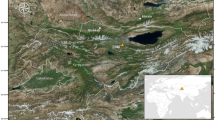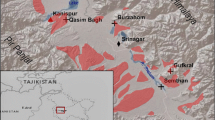Abstract
Three piles of shoots, leaves, and pods were discovered in the Zagunluk cemetery (about AD 100–400 based on 14C dating), Xinjiang, NW China. Morphological characteristics assigned the specimens to Medicago sativa L. (alfalfa). The preserved condition of alfalfa remains unambiguously indicate that the plant was of great economic importance and used as hay fodder at that time. This study provides the first systematic archeobotanical data about the forage utilization of alfalfa and the earliest relevant physical material so far known in China. Our results also help us to understand the dispersal of alfalfa across the Eurasia via the southern Xinjiang region and the cultural exchange information between China and the West.


Similar content being viewed by others
References
BCRBMAP (Bureau of Cultural Relics of Bayingolin Mongolian Autonomous Prefecture) (1992) A preliminary report on the excavations of the tombs at Zagunluk, Qiemo County in 1989. Xinjiang Cult Relics 25(2):1–14 (in Chinese)
Bergman F (1939) Archaeological researches in Sinkiang, especially the lop-nor region. Bokforlags Aktiebolaget Thule, Stockholm
Cheng Q, Wang B, Guo J (2011) The investigation of a glass unearthed from the Zagunluk cemetery, Qiemo, Xinjiang. Cult Relics 7:88–92 (in Chinese)
Cheng Q, Guo J, Wang B, Cui J (2012) Characteristics of chemical composition of glass finds from the Qiemo tomb sites on the silk road. Spectrosc Spectr Anal 32(7):1955–1960 (in Chinese with English abstract)
Chen X, Yu J, You Y (2017) Horse burial customs in Kalasu cemetery of Xinjiang seen from stable carbon and nitrogen isotope. W Reg Stud 4:89–98 (in Chinese with English abstract)
Cui D (1992) Germplasm resources of Medicago genus plants in Xinjiang. Xinjiang Agric Sci 5:226–228 (in Chinese)
Ge B, Wang H, Xie C, Cui Y, Zhu H, Zhou H (2008) Mitochondrial DNA analysis of Zhagunluke ancient population of Xinjiang in China. J Jilin Univ (Science Edition) 46(6):1206–1210 (in Chinese with English abstract)
Geng H (1995) Alfalfa in China. China Agriculture Press, Beijing (in Chinese)
Gong Y, Yang Y, Ferguson DK, Tao D, Li W, Wang C, Lv E, Jiang H (2011) Investigation of ancient noodles, cakes, and millet at the Subeixi site, Xinjiang, China. J Archaeol Sci 38(2):470–479
Griffiths FP (1949) Production and utilization of alfalfa. Econ Bot 3(2):170–183
Guo J, Zhu H (2015) Study on the spreading process and factors of alfalfa in China. J Anhui Agric Sci 43(21):390–392 (in Chinese with English abstract)
IAGP (The Institute of Archaeology of Gansu Province) (2005) Excavation of a Han dynasty site at Xuanquan near Dunhuang in Gansu. Cult Relics 5:4–20 (in Chinese with English abstract)
Jacomet S (2006) Identification of cereal remains from archaeological sites, 2nd edn. Basel University, IPAS. http://ipna.unibas.ch/archbot/pdf/Cereal_Id_Manual_engl.pdf
Jiang H, Li X, Zhao Y, Ferguson DK, Hueber F, Bera S, Wang Y, Zhao L, Liu C, Li C (2006) A new insight into Cannabis sativa (Cannabaceae) utilization from 2500-year-old Yanghai tombs, Xinjiang, China. J Ethnopharmacol 108(3):414–422
Jiang H, Li X, Ferguson DK, Wang Y, Liu C, Li C (2007a) The discovery of Capparis spinosa L. (Capparidaceae) in the Yanghai tombs (2800 years B.P.), NW China, and its medicinal implications. J Ethnopharmacol 113(3):409–420
Jiang H, Li X, Liu C, Wang Y, Li C (2007b) Fruits of Lithospermum officinale L. (Boraginaceae) used as an early plant decoration (2500 years BP) in Xinjiang, China. J Archaeol Sci 34(2):167–170
Jiang H, Zhang Y, Li X, Yao Y, Ferguson DK, Lv E, Li C (2009) Evidence for early viticulture in China: proof of a grapevine (Vitis vinifera L., Vitaceae) in the Yanghai tombs, Xinjiang. J Archaeol Sci 36(7):1458–1465
Li P, Sun J, Xing J (2012) On the origin and spread of alfalfa. Inner Mongolia Prataculture 24(1):5–8 (in Chinese)
Li Y (2014) Agricultural production in the Turfan Basin between the 5th and early 7th century. W Reg Stud 4:73–88 (in Chinese with English abstract)
Liu W (2002) Ancient Flora of Niya site. Agric Archaeol 1:63–67 (in Chinese)
Liu R (2010) The medicinal value of Medicago. Food Nutr China 7:76–78 (in Chinese with English abstract)
Liu H, Tian X, Zhang Y, Wang C, Jiang H (2013a) The discovery of Artemisia annua L. in the Shengjindian cemetery, Xinjiang, China and its implications for early uses of traditional Chinese herbal medicine qinghao. J Ethnopharmacol 146(1):278–286
Liu J, Mouri C, Laursen R, Zhao F, Zhou Y, Li W (2013b) Characterization of dyes in ancient textiles from Yingpan, Xinjiang. J Archaeol Sci 40:4444–4449
Miao Y, Zheng G, Lu X (2010) Discussion on the cultivation and utilization of alfalfa in ancient China. Chin Agric Sci Bull 26(17):403–407 (in Chinese with English abstract)
Muller MH, Poncet C, Prosperi JM, Santoni S, Ronfort J (2005) Domestication history in the Medicago sativa species complex: inferences from nuclear sequence polymorphism. Mol Ecol 15:1589–1602
Rafińska K, Pomastowski P, Wrona O, Górecki R, Buszewski B (2017) Medicago sativa as a source of secondary metabolites for agriculture and pharmaceutical industry. Phytochem Lett 20:520–539
Ramsey BC (2015) OxCal v4.2.4. Online: https://c14.arch.ox.ac.uk/oxcal/OxCal.html
Ramsey BC (2017) OxCal v4.3. Online: https://c14.arch.ox.ac.uk/oxcal/OxCal.html
Reimer PJ, Bard E, Bayliss A, Beck JW (2013) Selection and treatment of data for radiocarbon calibration: an update to the international calibration (IntCal) criteria. Radiocarbon 55(4 (IntCal 13)):1923–1945
Ruan Q (1999) A preliminary study of the settlement pattern of Niya site. W Reg Stud 2:48–57 (In Chinese)
Shao H (2008) The research of Zaghunluq culture in Xinjiang. Res China’s Front Archaeol 7:170–183 (in Chinese with English abstract)
Sheng G (2011) Flora of Xinjiang, vol 3. Xinjiang Science & Technology Publishing House, Urumchi (In Chinese)
Wang B (1983) Overview of the agricultural archaeology in Xinjiang. Agric Archaeol 1:102–121 (In Chinese)
Wang Y, Lu H (1993) Phytolith study and its application. Ocean Press, Beijing (in Chinese)
Wang B (2003) Konghou unearthed from the Zagunluk cemetery in Xinjiang. Cult Relics 2:56–62 (In Chinese)
Wang X, Chang J (2007) The livestock husbandry in Shan-Shan kingdom. J Chin Hist Geogr 22(2):94–100 (in Chinese with English abstract)
Ward G, Harbers LH, Blaha JJ (1979) Calcium-containing crystals in alfalfa: their fate in cattle. J Dairy Sci 62(5):715–722
Wen T (2016) Historical records (Shiji). The Chinese Publishing House, Beijing (in Chinese)
Xie M, Yang Y, Wang B, Wang C (2013) Interdisciplinary investigation on ancient Ephedra twigs from Gumugou cemetery (3800b.P.) in Xinjiang region, Northwest China. Microsc Res Tech 76(7):663–672
XUARM (Xinjiang Uighur Autonomous Region Museum) (1998) Excavations of five tombs at Zakunluk, Qiemo County. Xinjiang Cult Relics 51(3):2–18 (in Chinese)
XUARM (Xinjiang Uighur Autonomous Region Museum), BCRBMAP(Bureau of Cultural Relics of Bayingolin Mongolian Autonomous Prefecture) and BCRCC(Bureau of Cultural Relics of Charchan County) (2002) Brief report on the excavation of graveyard no.2 at Zagunluk, Qiemo. Xinjiang Cult Relics 1-2:1–21 (in Chinese)
XUARM (Xinjiang Uighur Autonomous Region Museum), BCRBMAP(Bureau of Cultural Relics of Bayingolin Mongolian Autonomous Prefecture) and BCRCC(Bureau of Cultural Relics of Charchan County) (2003a) Brief report on the 1998 excavation of the third-period culture graveyard of Zagunluk. Xinjiang Cult Relics (1): 1–19 (in Chinese)
XUARM (Xinjiang Uighur Autonomous Region Museum), BCRBMAP(Bureau of Cultural Relics of Bayingolin Mongolian Autonomous Prefecture) and BCRCC (Bureau of Cultural Relics of Charchan County) (2003b) Excavation of graveyard No. 1 at Zagunluk in Charchan, Xinjiang. Acta Archaeol Sin (1): 89–136 (in Chinese with English abstract)
XUARM (Xinjiang Uighur Autonomous Region Museum) (2016) Textile treasures of Zaghunluq. Cultural Relics Press, Beijing (in Chinese)
Yang Q, Sun Y (2011) The history, current situation and development of alfalfa breeding in China. Chin J Grassland 33(6):95–101 (in Chinese with English abstract)
Zhang J, Lu H, Wu N, Qin X, Wang L (2013) Palaeoenvironment and agriculture of ancient Loulan and Milan on the silk road. The Holocene 23(2):208–217
Zhang Y, Liu C (2016) History of the Han dynasty (Hanshu). The Chinese Publishing House, Beijing (in Chinese)
Zhou M (2004) Investigation of alfalfa cultivation in Chinese history. Grassland Turf 1:44–46 (in Chinese with English abstract)
Acknowledgments
The authors are grateful to the NSFC (41672171) for financial support, and to members of the Department of Archaeology and Anthropology in UCAS for useful discussions. We would also thank two anonymous reviewers for their valuable comments.
Author information
Authors and Affiliations
Corresponding author
Additional information
Publisher’s note
Springer Nature remains neutral with regard to jurisdictional claims in published maps and institutional affiliations.
Rights and permissions
About this article
Cite this article
Chen, T., Wang, B., Power, R.C. et al. The first archaeobotanical evidence of Medicago sativa L. in China: hay fodder for livestock. Archaeol Anthropol Sci 12, 2 (2020). https://doi.org/10.1007/s12520-019-00957-7
Received:
Accepted:
Published:
DOI: https://doi.org/10.1007/s12520-019-00957-7




